Research Division
Reprinted from "INSULATORS - Crown Jewels of the Wire", July 1972, page 32
In the Milholland
Most About Glass Insulators book there is a picture of an insulator listed as a Mine
insulator, page 115 (CD 188). This picture shows one way these insulators were
used. On telephone lines. In the early days of open wire line construction they were
used to a great extent by the independent telephone companies.
When I went to work in the year 1916 as a lineman for the Home Tel.
Co. of San
Diego, I placed these insulators on what was called a duplex crossarm. This
crossarm was like the present 10 pin arm, except the crossarm pins had threads on
both ends of the pins which extended through the crossarm. This type of arm
allowed 20 wires to be placed on one arm, 10 on top, 10 on the underside.
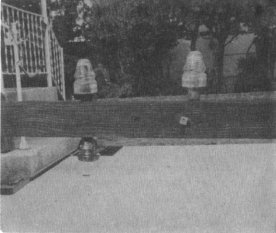
This type of construction did not prove very satisfactory because of the vibration of
the wires causing the insulators under the arm to come off the pins and come in
contact with the wires on the arm below. These insulators fit very nicely in any
insulator collection.
Fred C. Koehler
1512 Adoline Ave.
Fresno, Calif. 93728
The inquiry about B & O Insulators (April issue, page 24) stems from a lack of
differentiation between the Baltimore and Ohio Railroad and the Baltimore and Ohio
Telegraph Company. The following information condensed from Railroad Man's
Magazine for June 1916 (if authentic) may help to clarify this:
|
The Baltimore and Ohio Telegraph Company, first organized as a subsidiary of the
railroad system, was intended to cover the same area; later (When Western Union
Telegraph Company had absorbed most of the important competition) a separate
company was organized which branched out to the southwest after the
telegraphers' strike of 1883. Following the B & O Railroad to Cincinnati, their telegraph
wires entered St. Louis by way of the Ohio & Mississippi Railroad (later part of the B
& O Southwestern), then went south on the east bank of the river via the Cairo Short
Line Railroad to Cairo, Illinois, where they crossed the river by a cable to Bird's Point,
Missouri. There
they took the Texas & St. Louis (later the St. Louis,
Arkansas & Texas; the St. Louis Southwestern--the Cotton
Belt) to points in Arkansas and Texas. In 1887 B & O
amalgamated with Western Union. |
Aside from this description of the territory covered, the
rumor that B & O Telegraph insulators are located only in
Texas is unfounded, as I discovered a section of them on a
branch of the New York, New Haven & Hartford Railroad in
Connecticut, along with a few POSTAL TEL. Co., a company
with which the B & O Telegraph worked in mutual cooperation, opposing the competition of Western Union.
Margaret Oveson
North Grafton, MA 01536
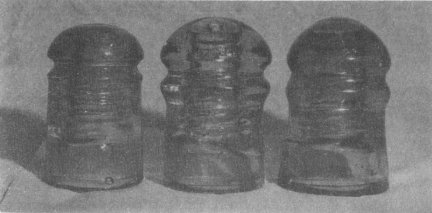
Enclosed find a photo taken by my son, Mike, also an
ardent insulator collector.
As you can see, the insulator on the right is quite a bit
different style from the CD 127 (left) and the CD 126
(middle). Embossing on the far right Insulator is: front -
W V T Co, CAUVETS PAT, W. BROOK FIELD; back - FEB 22 70,
NO. 55 FULTON ST N.Y.
Appreciate the Crown Jewels more every month
John Higbee
Muskogee, Okla.
Confusion about the relative ages of A.U. and W.U.
insulators (April issue, p. 24) is understandable.
Contrary to general belief Western Union didn't absorb all
of the old telegraph companies, but was itself absorbed,
though the name was carried on. It happened
this way, according to this account, briefed from Railroad Man's Magazine for June
1916:
| |
Western Union Telegraph Company's controlling interest was held by the
Vanderbilts; Jay Gould found it impossible to get into this business due to their
antagonism, so he and a few others formed the American Union Telegraph Company
in competition. A rate war followed; AU utilized every new invention for speeding
service, lured away WU's telegraphic talent in managers and operators, and
otherwise crowded WU to the wall. Finally a truce was called; at the ensuing
conference of their respective owners and stockholders AU took over,
absorbing
WU completely, but retained the Western Union name. |
Thus the Western Union name both preceded and followed American Union in point
of time; the dates given in this account are omitted, being at variance with
Woodward's 1969 Report. However, if the sequence is correct, it would account for
the appearance of the insulators described in the inquiry cited above.
Margaret Oveson
North Grafton, MA 01536
Enclosed is a photo of my first threadless. I'm wondering how many readers have
one like this in their collection?
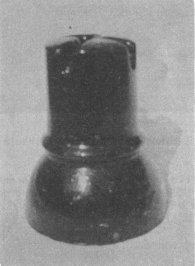
It's black glass rich amber when held to the light. Diameter of the base is 3-1/2 in.,
and it stands 4-1/4 in. tall. It's mint, dug in San Frisco and quite possibly made there?
As you can see, it has a nice cross top. I've never seen a cross top threadless
before. Have you?
Keep up the great work.
Sincerely,
Janet Bond
Antioch, Calif. 94509
P.S. The light marks in the photo are stones or seeds in the glass, Very crude glass.
Dear Mrs. Harned,
In my travels I found an insulator that's a little
different: a Beehive no name, that was made by the
American Insulator Company. These beehives usually have
three dates or two dates and very rarely, just one date,
which is always embossed on the rim. I have never seen or
heard of one without any embossing, and I'm quite sure
this is due to an error in making the insulator.
Denny Hackthorne from Riverside, California, and Ralph
Stegman from Catskill, N. Y., heard about this insulator
and came to see it, thinking it might be a fake. After
seeing it, they agree that it is truly an American
insulator. Denny made a trade for one from me and will
add it to his collection in Calif. My wife, Ann, and I
enjoyed their visit very much.
For some collectors who might not know the distinguishing
features of all types of American Insulators, here's a
drawing showing these points. (Bolow)
If any other collectors have found an American Insulator
without embossing, I would appreciate hearing from them.
Grant Barnes
24 Harlau Drive
Scotia, N. Y. 12302
(518) 399-4035
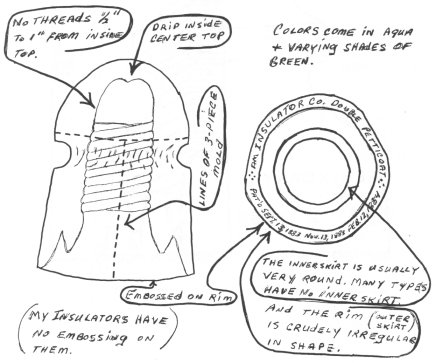
DISTINGUISHING FEATURES OF AN AMERICAN INSULATOR
Dear Dora:
Thought I'd write to you about an insulator I think is real good. I believe
it's a Hemingray experimental, as only 3 are known to have been found. I was
wondering who else might have one. The person I got this from said I have the
best one out of the three. I can't remember where it came from; I think he said
Tenn.
So readers, how many are there?
Thanks,
R. Case
Stillman Valley, Ill. 61084
(815) 645-8045
| FRONT |
HEMINGRAY
PATENT MAY 2 1893 |
| BACK |
HIGH VolTAGE No 3
TRIPLE PETTICOAT |
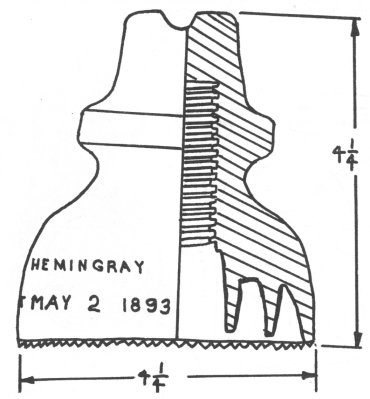
|
